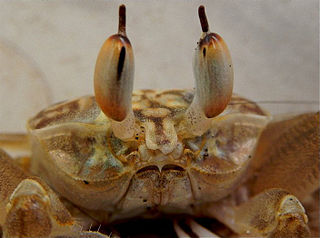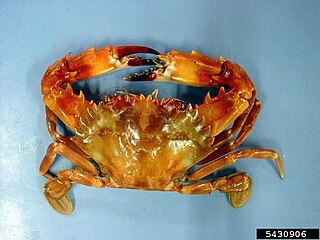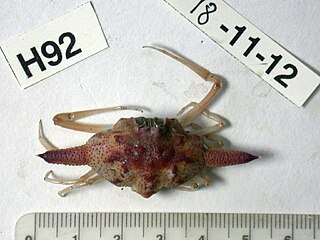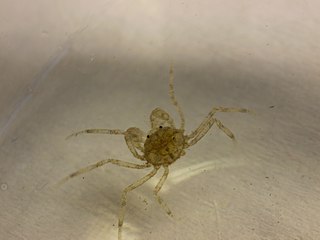
The graceful rock crab or slender crab, Metacarcinus gracilis or Cancer gracilis, is one of two members of the genus Metacarcinus, with white tipped chelae (claws). The second crab in the genus to have white tipped claws is M. magister. Both of these eastern Pacific crab species are recognized by ITIS as belonging to the much larger genus Cancer. M. gracilis has been caught from Alaska to Bahía Magdelena, Baja California. Although M. gracilis is only found in the Pacific Ocean, it has cousins in the Atlantic Ocean. The genus Cancer apparently evolved in the Pacific Ocean and later migrated to the Atlantic Ocean. Larvae and small juveniles of this species are often seen riding jellyfish, especially Phacellophora camtschatica. The juvenile crabs steal food from the jellyfish and also clean off parasitic amphipods.

Metacarcinus is a genus of crabs formerly included in the genus Cancer. It includes nine exclusively fossil species and five extant species, of which four are also known from the fossil record. A molecular study using the cytochrome oxidase I gene does not support the monophyly of this genus.

Oregonia bifurca, commonly known as the split-nose crab or the split-nose decorator crab, is a species of crabs belonging to the family Oregoniidae. It is a rare deep-water species that inhabits the tops of seamounts and guyots in the northeastern Pacific Ocean; from the Aleutian Islands, the Bering Sea, the Hawaiian–Emperor seamount chain, to the waters off British Columbia. It is closely related to the more common shallow-water species Oregonia gracilis, the graceful decorator crab.
Mithraculus cinctimanus is a species of crab in the family Majidae. It is found in the Caribbean region and is usually associated with a sea anemone, sponge or coral.
Brachynotus sexdentatus is a species of crab in the family Varunidae. It is native to the Mediterranean Sea and Black Sea, and became established for a time in Swansea Docks. It grows to a maximum carapace width of 18 mm (0.71 in), and lives in shallow water on muddy bottoms.

The gulf ghost crab, Hoplocypode occidentalis, is a species of ghost crabs native to the Pacific coast of the Americas, from the Gulf of California to Colombia. It is the only species in the genus Hoplocypode. Gulf ghost crabs are medium-sized, reaching a maximum overall body diameter of 6 in (15 cm). They are one of only two ghost crab species found in the eastern Pacific. However, gulf ghost crabs can easily be distinguished from painted ghost crabs by the absence of "horns" on their eyes.

Ocypode brevicornis is a species of ghost crab native to the Indian Ocean, from the Gulf of Oman to the Nicobar Islands. They are relatively large ghost crabs with a somewhat trapezoidal body. The carapace reaches a length of 41 mm (1.6 in) and a width of 50 mm (2.0 in). They are a mottled brown to yellow in coloration. Like other ghost crabs, one of their claws is much larger than the other. Their eyestalks are large and elongated, tipped with prolongations at the tip known as styles. They are common inhabitants of open sandy beaches, living in burrows in the intertidal zone.

Charybdis hellerii, the Indo-Pacific swimming crab or spiny hands is a species of crab from the swimming crab family, the Portunidae. Its native range covers the Indian and Pacific Oceans but it has been introduced to the western Atlantic and has invaded the Mediterranean. It is a commercially exploited species in south-east Asia.

Actea savignii is a species of Indo-Pacific crab from the family Xanthidae which is one of the spiny-legged rock crabs. It has colonised the Levantine Sea by Lessepsian migration through the Suez Canal from the Red Sea since the mid 2000s.

Ixa monodi, the Red Sea pebble crab is a species of pebble crab from the family Leucosiidae which prefers to burrow in sandy, shallow coastal waters. It was first described from the eastern Mediterranean where it is an invasive species having colonised the coasts of the Levantine Sea from the Red Sea by Lessepsian migration from the Red Sea via the Suez Canal.
Charybdis longicollis, the lesser swimming crab, is a species of crab from the swimming crab family, the Portunidae. It has a native range which covers the north-western Indian Ocean and it has invaded the Mediterranean Sea by Lessepsian migration through the Suez Canal.

Tubuca urvillei is a species of fiddler crab. It is found in Southeastern Africa from southern Somalia to South Africa and Madagascar.

Tubuca alcocki is a species of fiddler crab. Its range includes most of the northern Indian Ocean, from western Thailand, through the Bay of Bengal and India, to the Red Sea.

Neolithodes agassizii is a species of king crab native to the Western Atlantic. They live at depths of 200–1,900 metres (660–6,230 ft), and have been found as far south as Rio de Janeiro, as far north as latitude 36°, and near the Equator. It has been found in the southwestern Caribbean Sea as well as the Gulf of Mexico.

Leptuca is a genus of fiddler crabs belonging to the family Ocypodidae.
Leptuca speciosa, commonly known as the brilliant fiddler crab or the longfinger fiddler crab, is a species of fiddler crab native to the southern United States, Mexico, and the Caribbean.
Leptuca cumulanta, commonly known as the heaping fiddler crab or the mangrove fiddler crab, is a species of fiddler crab native to tropical and subtropical areas of the western Atlantic.

Limnopilos naiyanetri, commonly referred to as the Thai micro crab or pill-box crab, is a freshwater hymenosomatid crab endemic to Thailand. Its presence has only been confirmed in the Tha Chin River. The species was described in 1991 and represents the type species of Limnopilos. The Thai micro crab was first introduced to the aquarium hobby in 2008 when it was imported to Germany by the tropical fish importer Aquarium Glaser GmbH, and has slowly grown in popularity with aquarium hobbyists. It remains a relatively rare species on the market and detailed information on the husbandry of this species is scarce.

Limnopilos is a genus of small hymenosomatid crabs endemic to Southeast Asia. The genus was described by Christina Chuang and Peter Ng in 1991, who identified the new species Limnopilos naiyanetri and distinguished it from the closely related genus Hymenicoides. Its true taxonomic classification was debated for several years, but in 2007 the discovery of a new species of crab in this genus solidified the distinction between Limnopilos and Hymenicoides. Many aspects of the genus Limnopilos are still poorly understood. Their ecology and natural history have not been studied in detail, and their reproductive cycle remains mysterious.

Tiomanium indicum, commonly known as the Tioman crab or the white clawed mangrove crab, is a crab in the family Sesarmidae. It inhabits the Western and central Indo-Pacific ocean, including Singapore, Malaysia, Australia (Queensland), the Philippines and New Guinea. Tioman crabs are supralittoral. In Cairns, Australia they are known for moving in numbers in some seasons entering backyards and homes. This species was originally described by H. Milne Edwards in 1837 as Sesarma indicum. It was placed in a new genus Tiomanium by Serene and Soh The carapace is convex and 34 mm length. Key features that differentiate Tiomanium from Neosarmatium include a spine at the end of the upper inner margin of the cheliped palm and a spine on the upper inner angle of the carpus.














